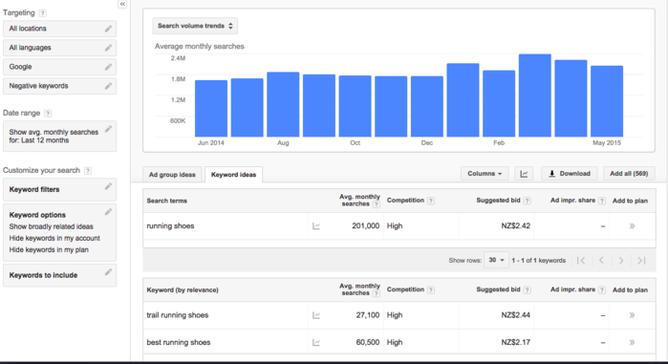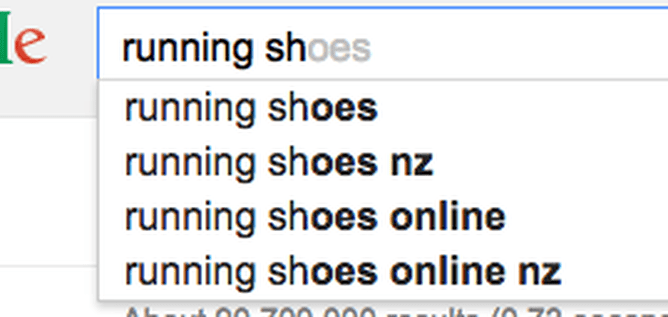Jeff Bezos built Amazon into a retail behemoth on the power of the long tail. And by applying long-tail principles to your SEO, you too could turn your own little website into something big; maybe not Amazon-big—but still big! (What is long-tail SEO? Check out Part 1 of this blog series to find out.)
So, how do you actually do long-tail SEO? Think of it in two steps:
Step 1: Identify your long-tail keywords
What are your long-tail keywords? There’s a few ways to find out:
- Google’s Keyword Planner. Signing up to Google Adwords, which is free, gives you access to their Keyword Tool. You can type in keywords and find out how many times per month on average it’s searched for. Not only that, but it’ll suggest other related keywords and how often they’re searched too. That way, you can identify what are the higher volume search terms. You can do a ton of other things with this tool, including restricting data to specific countries.
- Google suggested and related searches. You can get some pretty useful information just from regular ol’ search results in Google. For instance, when you type in a search phrase, Google suggests other related (and popular) queries, some of which are long-tail.
- Competitor analysis. You’ll get a good idea of strong keywords by looking at other similar websites that are already ranking well. Here’s a couple of ways to go about it:
- Pick a search query and see what ranks well. What phrases will your customers be typing into Google? Take a stab in the dark. Type in that search query, then visit the top-ranking websites. What language do those sites use? This will give you an idea of what terms and words might be useful. If you’re tech-savvy, you could also check the page source for their metatags. But this is just to stimulate your own thinking—don’t just copy-and-paste.
- Use a keyword density tool. For a more analytical approach, enter the URL of your competitor’s webpage and you’ll get a computer to crunch the numbers and identify the keywords for you.
Step 2: Craft your content around long-tail keywords
Keyword research is not an end; it’s a means. Once you’ve ascertained your long-tail keywords, the secret then is to craft your web content around those keywords. That way, when someone googles a related search query, fingers crossed, your website will show up near the top of the search results. Here’s a few things to keep in mind about crafting content:
- Use the keywords—but don’t overuse them. This is obvious (hopefully). You need to use the keywords in your copy. In fact, use it several times. Use it loads and it’ll have a better chance of ranking well for related searches. BUT there’s an old-fashioned, underhanded SEO technique where you use far too many keywords, such that it’s more about tricking the search engine than it is about informing your reader (called “keyword stuffing”). But Google et al. are smarter than they used to be. They can tell when you’re just trying to dupe them—and your ranking will suffer for it. So how do you use keywords without overusing them? The key: be natural. Tom Roberts of So What? Media advises, “Mention it as many times as you can without it appearing forced.”
- Write blog posts. Blogging is a really effective way to supercharge your search rankings. When you write a blog post, make sure you identify the important long-tail keywords and craft the copy around those keywords. One great thing about blogging is that it allows your to write on a wide range of (relevant) topics, thereby letting your capitalise on various niche search queries. You could even get extra mileage by writing a blog on the topic, linking those posts together. Find out more about links here.
- Create keyword-optimised landing pages. Blogging aside, it pays to make a page on your website that’s optimised for specific long-tail keywords. Let’s say you sell a range of brands through your online shoe store but you know there’s a sizeable group of your clientele who really want Mizuno shoes. Creating a page dedicated to Mizuno running shoes means you’re more likely to attract the Mizuno faithful.
- Put keywords in the headings. Search engines like Google figure that the words that appear in your headings, like the title of your blog post or its sub-headings, are especially relevant to the page’s topic. Therefore, the words used in headings have more oomph when it comes to search rankings. That means headings are the most bang-for-buck place to insert keywords.
There’s quite a lot more involved in writing great content. Get schooled in the fundamentals here.
Conclusion: long is the new short
There are no shortcuts to ranking well—not these days, at least. Google, Bing and other search engines are getting better at their job, which means that there are no shortcuts to ranking well (Want to know why? Check out Part 1 of this long tail SEO blog series). If you want to make it to the top, you have to provide great content.
But this content should be built around keywords. Going long-tail is smart because they’re low-competition, high-conversion keywords. But don’t be a one-trick pony. German university researchers have found that some long-tail experts (no doubt, often hucksters trying to sell long-tail services) sometimes overstate how much of your energies to devote to the long tail. Long-tail keywords are important but they’re just one of the many arrows you should have in your SEO quiver. Lucky for you, we’ve written quite a bit on the subject. Raise your game by reading more on SEO here.
Recap
- Identify long-tail keywords by using keyword tools (Google, HitTail), Google suggestions and competitor analysis.
- Craft your blog posts and web copy around long-tail keywords (without keyword stuffing).






